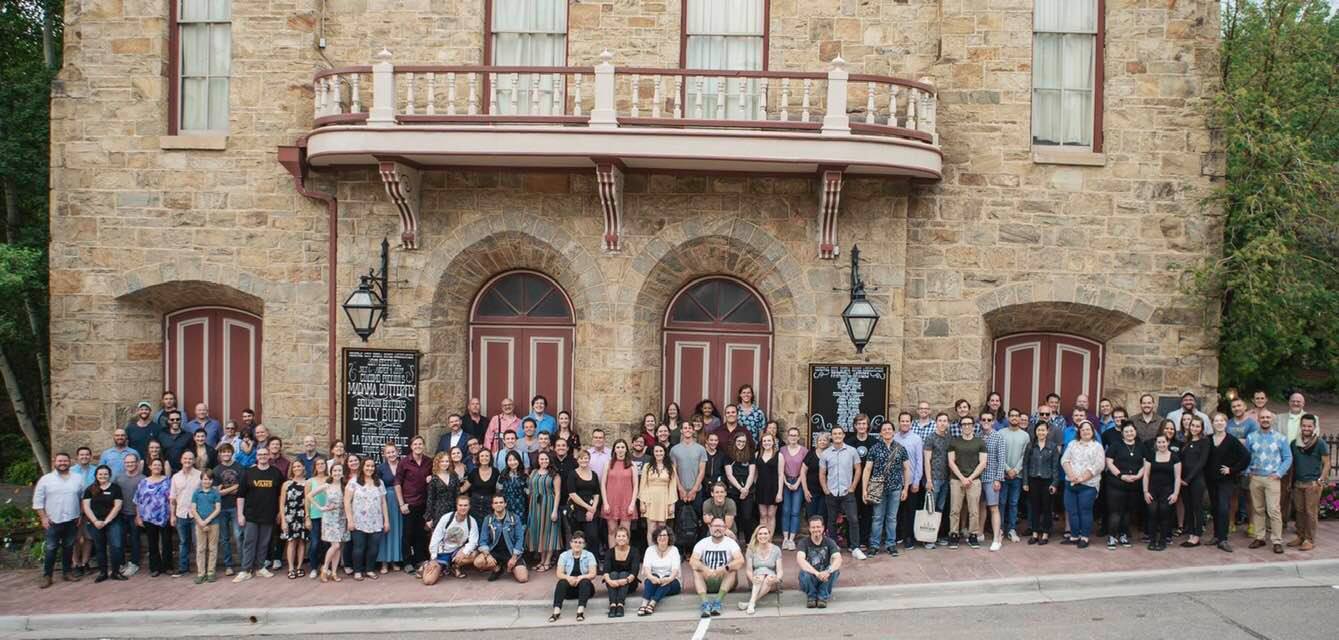IN DEPTH #2 / UNDERSTANDING THE PROBLEM(S)
Three primary areas of concern:
1) Fading Institutional Memory
2) Decaying & Unrecorded Physical Artifacts
3) Untapped Alumni Passion
1) FADING INSTITUTIONAL MEMORY
The turnover rate for leadership at arts nonprofits (especially department heads like directors of Development, Marketing, Education, etc) is notoriously high, by some metrics as fast as 16 months. While Central City Opera is no stranger to this phenomenon, leadership at the very top of the company (General Director, Music Director, Director of Development) has been unusually stable in recent decades:
Artistic Director Emeritus John Moriarty, a storied figure in American opera in the 20th century, was in some way or another in a leadership capacity at the company from 1978 to 2012.
The current leader, Pelham “Pat” Pearce, has been either the Managing Director or General/Artistic Director since the late 90’s.
John Baril, the Music Director, has been associated with the company in various roles since 1992.
Moriarty in particular is considered by many to be the company’s lodestar: a one-man wonder who single-handedly led the creation of the young artist training program over 40 years ago; took the helm of the company during a financially precarious time in the early 80s; helped raise its visibility and stature to become of the most noted summer opera festivals in the United States (and thereby its training program one of the most desirable and competitive for up-and-coming young singers); taught several generations of students in his various university roles in Boston; fostered and managed countless key relationships in both the town and across Colorado more broadly; wrote, played, published, conducted… you name it. And as far as longtime fans of the company are concerned, he did it all.
This is, of course, a double-edged sword: as soon as any one of them leaves, retires, or dies, they each take 20-30 year’s worth of institutional memory with them. For John Moriarty alone, that would be well over 40 years. And that’s not to mention everyone else who works there, but doesn’t last nearly as long.
Why does this matter?
For the first three decades after Central City Opera’s founding in 1932, the company enjoyed essentially a monopoly on summer opera performances in the United States; it became one of the summer venues worldwide for operatic stars based in New York. That began to change in the 50s and 60s as other summer festivals (like the Santa Fe Opera) were created, some of which eventually eclipsed Central City in scale or prestige. Like virtually all opera companies across America, financial highs and lows have marked the passage of time — and yet the company survives and, by many measures, continues to thrive to this day.
That said, with nearly 90 years of densely packed history concentrated at one theater in one town and with only a handful of executive leaders over the last 40 years, while much of that history is written down, it’s hard to find outside of either coffee-table books, niche fansites, or archives at university libraries which are thus far only accessible by showing up in person.
There is much to be lost — and quickly, at that.
[Decades’ worth of hand-painted billboards from the front of the opera house in stacks leaning against the walls of a rehearsal space at Central City Opera; the Penrose housing complex across the street from the theater; the author next to his name on one of the billboards during the 2010 season. Photos: Central City Opera, Joseph Gaines.]
2) DECAYING & UNRECORDED PHYSICAL ARTIFACTS
The Billboards
Wander into either the opera’s Foundry Rehearsal Center (a former blacksmith’s space, completely remodeled with large rehearsal spaces, several practice rooms, a prop shop, and offices), or the Williams Stables (a black box-like theater space used for classes, lectures, and small performances), and you’ll come across one of the opera’s iconic hand-painted billboards. Actually, you’ll come across dozens of them. In theory there should be 87 years’ worth (times two, one to the left of the opera house’s main entrance announcing the shows, and one to the right announcing the cast, directors, conductors, etc). They are everywhere, leaning against walls, stacked atop each other, mounted as artful room separators.
They are painted wood, unprotected (not under glass/plexiglass), most leaning precariously against walls, often in high-volume foot traffic areas. These are the most visible and iconic artifacts of the company’s nine-decade performance history — and, to my knowledge, no one has ever photographed them all.
The Headshots
To the right of the theater itself is the Cast House, a tightly packed two-story structure housing dressing rooms, wig and makeup studios, and the costume shop. Lining the walls of every dressing room, the hallways, the stairwell, and the entryway are dozens of framed headshots of the artists who have performed on the Central City Opera stage, as well as directors, conductors, designers, composers — basically anyone whose name would have appeared on those billboards on the front of the house should in theory have a framed photo.
It is quite literally a rogues’ gallery of virtually all the stars at the company ever (or many of them, anyway). Not only have few of these been digitally archived, which makes them (like the billboards) vulnerable to permanent loss from fire or water damage, they are also in a staff-only area, no one besides current employees and contractors ever sees them or even knows they’re there.
The Buildings
Then there are the 30-some-odd historic properties themselves, many dating from the late 19th and early 20th centuries. Most are period residential buildings, meticulously preserved both for their own sake as well as providing critical housing for the dozens of artists who travel from across the world to collaborate each summer at the opera festival.
Aside from some light information on just a handful of the more notable structures, there are no readily available records of the stories of who built these often beautiful, period homes, when they were constructed, who occupied them, and how they came to be in the company’s possession. There are also certainly no photos, or anything indicating where in town the properties might be. The only indications for most visitors to the company’s website are merely a statistic.
Opening night of a performance at Central City Opera in this undated photo. Photo: Central City Opera.
Why does this matter?
For an organization built so literally amidst the physical relics of its history, it makes no sense not to have recorded and made readily available to the public the stories and images that bring the company to life in the fullest visual, tactile, and enduring ways.
But it also unintentionally masks the full scale of the company, hiding its accomplishments, its wealth of history, and the true impact the opera company has had both on its local and state communities as well as the industry as a whole. In so doing, its unique dual role as theater producer and architectural conservator is also often completely lost to online visitors.
These are missed opportunities to showcase the full value of Central City Opera to potential donors and volunteer leadership, to audiences and fans, to industry peers, and to the country as a whole.
The Central City Opera 2019 company photo, featuring many (though not all) of the dozens of people who collaborated to produce and perform the shows that summer, taken in front of the opera house. Photo: Amanda Tipton / Central City Opera.
3) UNTAPPED ALUMNI PASSION
As Emily and I sat together on that summer day in 2018, it was nearing the end of the opera’s 10-week performance season, and as often happens with the two of us, the conversation drifted gradually towards the biggest of big pictures: in a culture that has largely lost its connection with the art form, and in an economy in which fewer and fewer Americans can afford to go to the movies, let alone the opera, what does the future hold for this company?
We each had a long history performing there, we both shared a passion for Central City Opera — what is was, what it is now, what it could become years hence. We observed how much fierce loyalty and affection there is for the company among many who’ve passed through in recent decades, and we wondered what it would take to harness that. We lamented the fact that the company had limited resources to do anything about it.
I’ve had similar versions of this same conversation with countless other “alumni” of the company play out over the years: we start with our shared, (not all, but mostly) joyful experiences there, drifting to wondering about where “everybody else from that summer is now” — then often on to deep frustrations how “they could be doing so much more” to lift the company’s fortunes.
Who is “they?” The staff? Executive leadership? The board? This company, like all opera companies, is often already operating at the limits allowed by time and money.
As with many other endeavors in life, beyond a certain point, there is no “they” — there is only us.
Why does this matter?
And ask anyone who has ever worked or volunteered at Central City Opera in any capacity — there is a wealth of stories created year after year in this extraordinarily unique place, the collective narrative of which makes it a much greater entity than merely an established arts nonprofit with a nice track record.
Stories are the lifeblood of any opera company, and many of the nearly nine decades’ worth created here are by and large not being recorded.
Not only that, but bound up in this storytelling, these shared histories, there’s often an intense desire to be able to help the company do something. But of course the first response that the vast majority of those working in the American opera industry would have to this proposition is, “I don’t have much if any money to give. What else can I do?”
Well, then, what if we created:
A virtual place for the gathering of these stories?
A focused effort to harness all this positive energy, and a clearinghouse for ideas about what else can be done to help?
A place for digital archiving of things and places which everyone who was there will recognize and maybe want to know more about?
A website with a real backlog of possible projects both to buttress and elevate the company, but also to help grow and magnify its leadership role in the industry as a whole?
From a community organizing perspective, if you already have a global army of intensely creative and highly motivated people with deeply personal connections to your organization, why the heck would you not try to take advantage of that?
Membrs of the 2019 Bonfils-Stanton Artist Training Program. Photo: Amanda Olea / Facebook.









